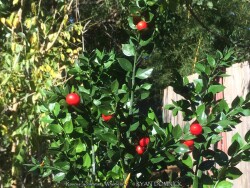

Wheelers Butcher's Broom (Ruscus aculeatus 'Wheelers') is the ultimate dry-shade plant for eastern Kansas landscapes. They are native to dry shaded woodland and hedgerows in England and along coastal cliffs. Butcher's Broom has everything a shade gardener might ask for; dependable dark green foliage, colorful red long-lasting fruits, evergreen during winter, and ease of care with very low maintenance. "Leaves" are actually "cladodes" (flattened, leaf-like stem tissue that photosynthesises) Evergreen foliage is bristly, shrub-like, and hardy to about -10°F. If it gets colder than that, ruscus will be deciduous and will slowly recover in summer. The red berries which sit squarely on the middle of the "leaves" on established plants persisting for a few months through the fall! Ruscus tolerate deep shade but some filtered or morning sun is best for optimal growth in our colder climate. With prickly foliage, these plants resist deer and rabbit browsing. Ruscus tolerates most soils except for poorly drained ones. Growth is quite slow with young plants but speeds up with establishment and rich soils with regular water. It is best to start with large plants as establishment and full winter-hardiness will occur much faster. A thick layer of mulch greatly helps with cold hardiness. Established plants have thrived in our Lawrence Kansas zone 6a display garden for over 10 years enduring temperatures as low as -18°F. Ruscus aculeatus 'Wheeler's' is self-fertile, not needing a male plant for pollination.
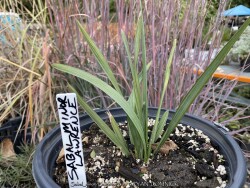

Hardy Dwarf Palmetto (Sabal minor) is among the world's most cold-hardy palms and spread over a large geographical area in the Southeast USA. Green foliage is waxy and fan-like; typical of any fan palm. When grown in a northern climate such as Kansas, growth is pretty slow at first and some winter damage should be expected if temperatures drop below -5 degrees F. It is advisable to mulch the crown of a newly planted Sabal minor with 6 to 8 inches of mulch for the first few years. Established plants get about 2 to 3 feet tall after 10-20 years. Sabal minor tolerate excessive moisture and rain gardens but prefer rich well-drained soil. Sabal minor needs full sun and a hot and humid (Kansas) summer to build up stored energy for the next winter. They are also notably drought tolerant if established and grown in full sun. Useful in the landscape as a tropical looking evergreen specimen plant. Unlike other Evergreens, needle palm maintains bright green foliage, not dingy olive green like many conifers. Combine with just about any other flowering plants and most garden themes. This true palm, however, is a must for any tropical theme garden. Mix with hardy banana (Musa basjoo), canna, or crinum lily! Growth is quite slow with young plants but speeds up with establishment and rich soils, regular water, and full sun. It is best to start with large plants as establishment and full winter-hardiness will occur much faster. A thick layer of mulch greatly helps with cold hardiness. South or West exposure is best. Sabal minor 'Lawrence' was named by Plant Delights Nursery after Ryan Domnick (the Author) growing it on the South side of a building in Lawrence, KS in 2013 with no mulch. The origin of the original plant (actually 2 plants) is a mystery but new seed has been collected every year since. Seedlings of this survivor plants are sold as Sabal minor 'Lawrence'. After confirmation in fall of 2021, the original plants are still thriving and setting seed after the worst winter in 30-50 years. During that arctic blast of February, 2021, lows down to -17 degrees F on Feb 16th, 2021 were recorded. The longevity of this cold blast was also impressive: 10 days on a row with highs of 10-15 degrees F or lower, 8 nights of lows in the single digits and negatives, and 36 straight hours of 0 degrees F and mostly lower. The two established specimens survived with varying degrees of foliage damage but with complete recovery by summer and 5-7 fully formed leaves by fall. It is estimated they have been in the ground since 2011-2012 and are 2-3' tall. Repeated or successive cold winters with complete foliage loss can be an issue with this and many evergreen zone 6/7 plants. One occasional difficult winter followed by mild winters is more tolerable. Avoid North-facing exposures.
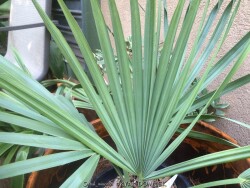

Hardy Dwarf Palmetto (Sabal minor) is among the world's most cold-hardy palms and spread over a large geographical area in the Southeast USA. Green foliage is waxy and fan-like; typical of any fan palm. When grown in a northern climate such as Kansas, growth is pretty slow at first and some winter damage should be expected if temperatures drop below -5 degrees F. It is advisable to mulch the crown of a newly planted Sabal minor with 6 to 8 inches of mulch for the first few years. Established plants get about 2 to 3 feet tall after 10-20 years. Sabal minor tolerate excessive moisture and rain gardens but prefer rich well-drained soil. Sabal minor needs full sun and a hot and humid (Kansas) summer to build up stored energy for the next winter. They are also notably drought tolerant if established and grown in full sun. Useful in the landscape as a tropical looking evergreen specimen plant. Unlike other Evergreens, needle palm maintains bright green foliage, not dingy olive green like many conifers. Combine with just about any other flowering plants and most garden themes. This true palm, however, is a must for any tropical theme garden. Mix with hardy banana (Musa basjoo), canna, or crinum lily! Growth is quite slow with young plants but speeds up with establishment and rich soils, regular water, and full sun. It is best to start with large plants as establishment and full winter-hardiness will occur much faster. A thick layer of mulch greatly helps with cold hardiness. South or West exposure is best. Established plants have been spotted in Oklahoma enduring temperatures as low as -13°F in 2021. One population of Sabal minor is actually native as far North as Oklahoma (Southeast corner); a resulting variety has been named Sabal minor 'McCurtain'. Plants have been recorded handling -24F in Wichita, KS. 'McCurtain' tends to grow larger and faster than the common species; which is good for replacing lost energy from winterkill. Avoid North-facing exposures.
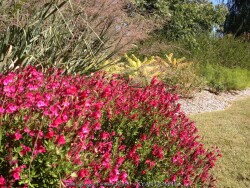

>>>>>In Lawrence, KS (zone 6a), many dozen established specimens survived -17 degrees F. During the arctic blast of February, 2021, lows down to -17 degrees F on Feb 16th, 2021 were recorded. The longevity of this cold blast was also impressive: 10 days on a row with highs of 10-15 degrees F or lower, 8 nights of lows in the single digits and negatives, and 36 strait hours of 0 degrees F and mostly lower. All survivors had winter sun with South exposures, those without perrished. Repeated or successive cold winters with complete foliage loss seem can be an issue with this and many evergreen zone 6/7 plants. One occasional difficult winter followed by mild winters is more tolerable. This is, however, a very vigorous growing plant so generally will recover in one summer. Avoid North-facing exposures, North sides of a berm, and spots with excessive snow accumulation.
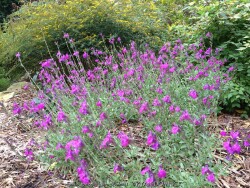

Ultra Violet Autumn Sage, is also known as Salvia greggii 'Ultra Violet'
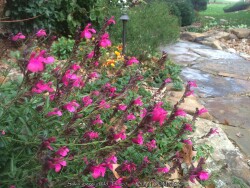

>>>>>In Eastern Kansas, this cultivar performs WELL with just about everything nature has to challenge it! Extreme heat and drought are tolerated. Cold tolerance is no problem in our zone 6. If winter die-back occurs, cut back in March/April and flowers will occur on new growth this year. No disease or pest problems. Great plant for berms, hot West or South exposures, and most any other garden situations in full sun. Will tolerate clay soils and extra moisture in summer. Combine with caryopteris, crapemyrtle, and butterflybush to create a late season "all you can eat" buffet for pollinators!
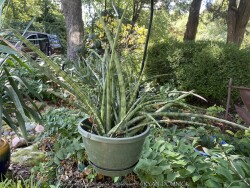

Green tube-like leaves from this Cylindrical Sansevieria (Sansevieria / Dracaena angolensis) make an excellent architectural statement. Most Sansevieria are native to are native to rocky, dry habitats in tropical Africa but used as a patio or house plant in Kansas. Grow in full sun to part sun with optional extra watering including that which comes from rainfall. Plants with plenty of time to acclimate will thrive in full sun but be careful not to rush it or sunburning will occur. Generally if moving outside for the summer, allow 2-3 weeks of part shade or morning sun before placing in full sun. Or just keep in part shade or under an overhang. Repotting may or may not be needed depending on how large you want the plant to grow; plants can continue to grow and tolerate extremely root-bound pots but may need wind bracing. Some species root systems will build up enough pressure and will simply break the pot as a friendly reminder when it's time to re-pot! Protect from temperatures below 45 degrees F and move into a bright window over the winter with no watering. Do not allow Sansevieria to freeze or even get close to freezing especially if soil is wet or death may occur. As a winter house plant, it will look presentable all winter long with just a few monthly or no waterings if you forget. As a permanent house plant, provide bright light and allow the soil to dry between waterings for many years of carefree enjoyment. Potted plants are very low maintenance needing only old leaves trimmed once per year. Cylindrical Sansevieria is often grown as a specimen or hanging basket plant.
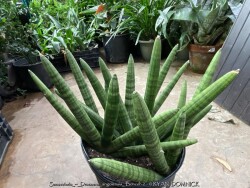

Dwarf green tube-like leaves from this Starfish Sansevieria (Sansevieria / Dracaena angolensis 'Boncel') make an excellent architectural statement. Most Sansevieria are native to are native to rocky, dry habitats in tropical Africa but used as a patio or house plant in Kansas. Grow in full sun to part sun with optional extra watering including that which comes from rainfall. Plants with plenty of time to acclimate will thrive in full sun but be careful not to rush it or sunburning will occur. Generally if moving outside for the summer, allow 2-3 weeks of part shade or morning sun before placing in full sun. Or just keep in part shade or under an overhang. Repotting may or may not be needed depending on how large you want the plant to grow; plants can continue to grow and tolerate extremely root-bound pots but may need wind bracing. Some species root systems will build up enough pressure and will simply break the pot as a friendly reminder when it's time to re-pot! Protect from temperatures below 45 degrees F and move into a bright window over the winter with no watering. Do not allow Sansevieria to freeze or even get close to freezing especially if soil is wet or death may occur. As a winter house plant, it will look presentable all winter long with just a few monthly or no waterings if you forget. As a permanent house plant, provide bright light and allow the soil to dry between waterings for many years of carefree enjoyment. Potted plants are very low maintenance needing only old leaves trimmed once per year. Starfish Sansevieria is one of the more slow-growing and most sought-after snake plants often grown as a specimen house plant. Starfish is relatively rare and will command a higher price than most other houseplants.


Extra wide blue-green speckled leaves from this Whale Fin Sansevieria (Sansevieria / Dracaena masoniana) make an excellent architectural statement. Most Sansevieria are native to are native to rocky, dry habitats in tropical Africa but used as a patio or house plant in Kansas. Grow in full sun to part sun with optional extra watering including that which comes from rainfall. Plants with plenty of time to acclimate will thrive in full sun but be careful not to rush it or sunburning will occur. Generally if moving outside for the summer, allow 2-3 weeks of part shade or morning sun before placing in full sun. Or just keep in part shade or under an overhang. Repotting may or may not be needed depending on how large you want the plant to grow; plants can continue to grow and tolerate extremely root-bound pots but may need wind bracing. Some species root systems will build up enough pressure and will simply break the pot as a friendly reminder when it's time to re-pot! Protect from temperatures below 45 degrees F and move into a bright window over the winter with no watering. Do not allow Sansevieria to freeze or even get close to freezing especially if soil is wet or death may occur. As a winter house plant, it will look presentable all winter long with just a few monthly or no waterings if you forget. As a permanent house plant, provide bright light and allow the soil to dry between waterings for many years of carefree enjoyment. Potted plants are very low maintenance needing only old leaves trimmed once per year. Whale Fin Sansevieria is one of the more slow-growing and most sought-after snake plants often grown as a specimen house plant. Largest leaves of all sansevierias! Whale Fin is rare and will command a higher price than most other houseplants.
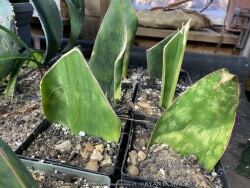

Extra wide blue-green speckled leaves from this Whale Fin Sansevieria (Sansevieria / Dracaena masoniana) make an excellent architectural statement. Most Sansevieria are native to are native to rocky, dry habitats in tropical Africa but used as a patio or house plant in Kansas. Grow in full sun to part sun with optional extra watering including that which comes from rainfall. Plants with plenty of time to acclimate will thrive in full sun but be careful not to rush it or sunburning will occur. Generally if moving outside for the summer, allow 2-3 weeks of part shade or morning sun before placing in full sun. Or just keep in part shade or under an overhang. Repotting may or may not be needed depending on how large you want the plant to grow; plants can continue to grow and tolerate extremely root-bound pots but may need wind bracing. Some species root systems will build up enough pressure and will simply break the pot as a friendly reminder when it's time to re-pot! Protect from temperatures below 45 degrees F and move into a bright window over the winter with no watering. Do not allow Sansevieria to freeze or even get close to freezing especially if soil is wet or death may occur. As a winter house plant, it will look presentable all winter long with just a few monthly or no waterings if you forget. As a permanent house plant, provide bright light and allow the soil to dry between waterings for many years of carefree enjoyment. Potted plants are very low maintenance needing only old leaves trimmed once per year. Whale Fin Sansevieria is one of the more slow-growing and most sought-after snake plants often grown as a specimen house plant. Largest leaves of all sansevierias! Whale Fin is rare and will command a higher price than most other houseplants.
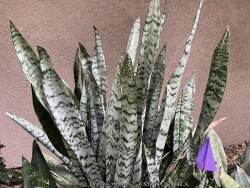

Green to light green leaves from this Sansevieria (Sansevieria / Dracaena trifasciata) make an excellent architectural statement. Most Sansevieria are native to are native to rocky, dry habitats in tropical Africa but used as a patio or house plant in Kansas. Grow in full sun to part sun with optional extra watering including that which comes from rainfall. Plants with plenty of time to acclimate will thrive in full sun but be careful not to rush it or sunburning will occur. Generally if moving outside for the summer, allow 2-3 weeks of part shade or morning sun before placing in full sun. Or just keep in part shade or under an overhang. Repotting may or may not be needed depending on how large you want the plant to grow; plants can continue to grow and tolerate extremely root-bound pots but may need wind bracing. Some species root systems will build up enough pressure and will simply break the pot as a friendly reminder when it's time to re-pot! Protect from temperatures below 45 degrees F and move into a bright window over the winter with no watering. Do not allow Sansevieria to freeze or even get close to freezing especially if soil is wet or death may occur. As a winter house plant, it will look presentable all winter long with just a few monthly or no waterings if you forget. As a permanent house plant, provide bright light and allow the soil to dry between waterings for many years of carefree enjoyment. Potted plants are very low maintenance needing only old leaves trimmed once per year. This is the basic big-box store sansevieria is often grown as a house plant.
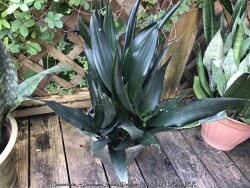

Dark solid green leaves from this Sansevieria (Sansevieria / Dracaena trifasciata 'Black Dragon') make an excellent architectural statement. Most Sansevieria are native to are native to rocky, dry habitats in tropical Africa but used as a patio or house plant in Kansas. Grow in full sun to part sun with optional extra watering including that which comes from rainfall. Plants with plenty of time to acclimate will thrive in full sun but be careful not to rush it or sunburning will occur. Generally if moving outside for the summer, allow 2-3 weeks of part shade or morning sun before placing in full sun. Or just keep in part shade or under an overhang. Repotting may or may not be needed depending on how large you want the plant to grow; plants can continue to grow and tolerate extremely root-bound pots but may need wind bracing. Some species root systems will build up enough pressure and will simply break the pot as a friendly reminder when it's time to re-pot! Protect from temperatures below 45 degrees F and move into a bright window over the winter with no watering. Do not allow Sansevieria to freeze or even get close to freezing especially if soil is wet or death may occur. As a winter house plant, it will look presentable all winter long with just a few monthly or no waterings if you forget. As a permanent house plant, provide bright light and allow the soil to dry between waterings for many years of carefree enjoyment. Potted plants are very low maintenance needing only old leaves trimmed once per year. Black Dragon Sansevieria is one of the more slow-growing and most sought-after snake plants often grown as a specimen house plant.
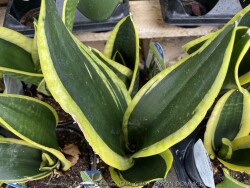

Dark green and gold striped leaves from this Sansevieria (Sansevieria / Dracaena trifasciata 'Black Gold') make an excellent architectural statement. Most Sansevieria are native to are native to rocky, dry habitats in tropical Africa but used as a patio or house plant in Kansas. Grow in full sun to part sun with optional extra watering including that which comes from rainfall. Plants with plenty of time to acclimate will thrive in full sun but be careful not to rush it or sunburning will occur. Generally if moving outside for the summer, allow 2-3 weeks of part shade or morning sun before placing in full sun. Or just keep in part shade or under an overhang. Repotting may or may not be needed depending on how large you want the plant to grow; plants can continue to grow and tolerate extremely root-bound pots but may need wind bracing. Some species root systems will build up enough pressure and will simply break the pot as a friendly reminder when it's time to re-pot! Protect from temperatures below 45 degrees F and move into a bright window over the winter with no watering. Do not allow Sansevieria to freeze or even get close to freezing especially if soil is wet or death may occur. As a winter house plant, it will look presentable all winter long with just a few monthly or no waterings if you forget. As a permanent house plant, provide bright light and allow the soil to dry between waterings for many years of carefree enjoyment. Potted plants are very low maintenance needing only old leaves trimmed once per year. Black Gold Sansevieria is one of the more slow-growing and most sought-after snake plants often grown as a specimen house plant.
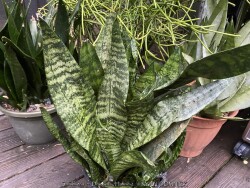

Compact Green to light green leaves from this Dwarf Sansevieria (Sansevieria / Dracaena trifasciata 'Hahnii') make an excellent architectural statement. Most Sansevieria are native to are native to rocky, dry habitats in tropical Africa but used as a patio or house plant in Kansas. Grow in full sun to part sun with optional extra watering including that which comes from rainfall. Plants with plenty of time to acclimate will thrive in full sun but be careful not to rush it or sunburning will occur. Generally if moving outside for the summer, allow 2-3 weeks of part shade or morning sun before placing in full sun. Or just keep in part shade or under an overhang. Repotting may or may not be needed depending on how large you want the plant to grow; plants can continue to grow and tolerate extremely root-bound pots but may need wind bracing. Some species root systems will build up enough pressure and will simply break the pot as a friendly reminder when it's time to re-pot! Protect from temperatures below 45 degrees F and move into a bright window over the winter with no watering. Do not allow Sansevieria to freeze or even get close to freezing especially if soil is wet or death may occur. As a winter house plant, it will look presentable all winter long with just a few monthly or no waterings if you forget. As a permanent house plant, provide bright light and allow the soil to dry between waterings for many years of carefree enjoyment. Potted plants are very low maintenance needing only old leaves trimmed once per year. This is one of the basic big-box store sansevierias often grown as a house plant.
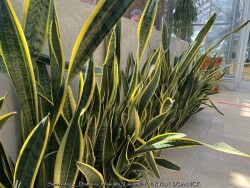

Green and yellow leaves from this Sansevieria (Sansevieria / Dracaena trifasciata 'Laurentii') make an excellent architectural statement. Most Sansevieria are native to are native to rocky, dry habitats in tropical Africa but used as a patio or house plant in Kansas. Grow in full sun to part sun with optional extra watering including that which comes from rainfall. Plants with plenty of time to acclimate will thrive in full sun but be careful not to rush it or sunburning will occur. Generally if moving outside for the summer, allow 2-3 weeks of part shade or morning sun before placing in full sun. Or just keep in part shade or under an overhang. Repotting may or may not be needed depending on how large you want the plant to grow; plants can continue to grow and tolerate extremely root-bound pots but may need wind bracing. Some species root systems will build up enough pressure and will simply break the pot as a friendly reminder when it's time to re-pot! Protect from temperatures below 45 degrees F and move into a bright window over the winter with no watering. Do not allow Sansevieria to freeze or even get close to freezing especially if soil is wet or death may occur. As a winter house plant, it will look presentable all winter long with just a few monthly or no waterings if you forget. As a permanent house plant, provide bright light and allow the soil to dry between waterings for many years of carefree enjoyment. Potted plants are very low maintenance needing only old leaves trimmed once per year. This is the basic big-box store sansevieria is often grown as a house plant.
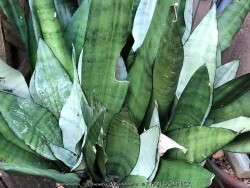

Dwarf whitish green leaves from this Moonshine Sansevieria (Sansevieria / Dracaena trifasciata 'Moonshine') make an excellent architectural statement. Most Sansevieria are native to are native to rocky, dry habitats in tropical Africa but used as a patio or house plant in Kansas. Grow in full sun to part sun with optional extra watering including that which comes from rainfall. Plants with plenty of time to acclimate will thrive in full sun but be careful not to rush it or sunburning will occur. Generally if moving outside for the summer, allow 2-3 weeks of part shade or morning sun before placing in full sun. Or just keep in part shade or under an overhang. Repotting may or may not be needed depending on how large you want the plant to grow; plants can continue to grow and tolerate extremely root-bound pots but may need wind bracing. Some species root systems will build up enough pressure and will simply break the pot as a friendly reminder when it's time to re-pot! Protect from temperatures below 45 degrees F and move into a bright window over the winter with no watering. Do not allow Sansevieria to freeze or even get close to freezing especially if soil is wet or death may occur. As a winter house plant, it will look presentable all winter long with just a few monthly or no waterings if you forget. As a permanent house plant, provide bright light and allow the soil to dry between waterings for many years of carefree enjoyment. Potted plants are very low maintenance needing only old leaves trimmed once per year. Moonshine Sansevieria is one of the more slow-growing and most sought-after snake plants often grown as a specimen house plant.
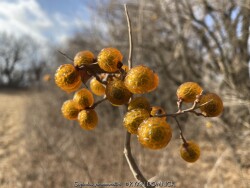

***Tree descriptions available with future update!***
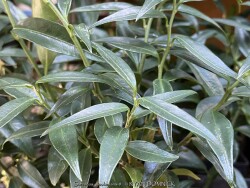

Himalayan Sweet Box (Sarcococca hookeriana) is planted for its evergreen dark green foliage and white flowers. Foliage maintains well all year provided that certain cultural conditions are met. Native to shaded mountain areas in forests, valleys or along streams in the Himalayas, it needs moist soil rich in organic matter avoiding too much clay. It is somewhat drought tolerant once established. If low temperatures hit -5 to -10 degrees F, foliage finally dies back to the ground and re-emerges in early spring. Generally this plant can decline after a few years of Kansas climate but is worth a try in perfect soils in well-tended shade gardens. If low temperatures hit -10 degrees F, it may kill an un-mulched plant; protect any zone 6 plant with thick layer of mulch. Lack of moisture and competition with weeds seem to be an issue but it survives just fine. Growth is extremely slow. This is one of the most deep shade tolerant plants available.
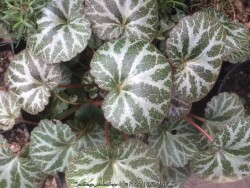

Hardy Strawberry Geranium, is also known as Saxifraga stolonifera
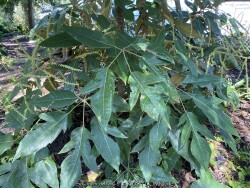

***Description for this plant available with future update!***


Little bluestem (Schizachyrium scoparium) is a prominent prairie grass usually found in the short to medium grass prairies of Kansas and most common in the midwest and Great Plains. It also occurs sporadically throughout most of the United States in open areas where trees cannot grow. The spring and summer foliage is mint green to blue green. Depending on the variety, they gradually turn a reddish purple color in late summer progressing to deeper reddish purple, red, or orange by fall. At this time when the seed heads have extended, it is at its prettiest. As cold weather sets in and freezes occur, dried foliage turns a pinkish orange with tan and red shades again depending on the variety. Winter color is persistent and lasts until spring cut back in March. Little bluestem is very tolerant of different soils but prefers dry, sandy, loam, or clay soils with plenty of full sun. If planted in rich soil or given too much water, plants tend to grow too tall and flop by late summer. However, there are now improved cultivars that resist flopping. Good air circulation and some wind is needed to avoid rust diseases in humid areas. Sometimes if planted too shallow or if mulched too thickly, plants can heave and die in the winter. In the landscape, little bluestem looks best when planted in medium to large groups giving the look of a miniature prairie. It also combines very well with many other plants that have different textures and colors. Generally if given the proper placement and growing conditions, little bluestem will last indefinitely. Little bluestem as one of the four major grasses (along with Big bluestem, Indiangrass, and Switchgrass) covering millions of acres and Kansas including the Flint Hills. Where and when conditions are safe, it can be burned in late winter or early spring in a prairie or meadow before new growth appears. Many cultivars have been released improving foliage color and flop resistance.
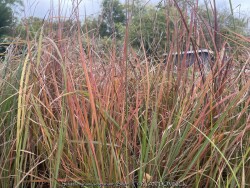

Little bluestem (Schizachyrium scoparium) is a prominent prairie grass usually found in the short to medium grass prairies of Kansas and most common in the midwest and Great Plains. It also occurs sporadically throughout most of the United States in open areas where trees cannot grow. The spring and summer foliage is mint green to blue green. Depending on the variety, they gradually turn a reddish purple color in late summer progressing to deeper reddish purple, red, or orange by fall. At this time when the seed heads have extended, it is at its prettiest. As cold weather sets in and freezes occur, dried foliage turns a pinkish orange with tan and red shades again depending on the variety. Winter color is persistent and lasts until spring cut back in March. Little bluestem is very tolerant of different soils but prefers dry, sandy, loam, or clay soils with plenty of full sun. If planted in rich soil or given too much water, plants tend to grow too tall and flop by late summer. However, there are now improved cultivars that resist flopping. Good air circulation and some wind is needed to avoid rust diseases in humid areas. Sometimes if planted too shallow or if mulched too thickly, plants can heave and die in the winter. In the landscape, little bluestem looks best when planted in medium to large groups giving the look of a miniature prairie. It also combines very well with many other plants that have different textures and colors. Generally if given the proper placement and growing conditions, little bluestem will last indefinitely. Little bluestem as one of the four major grasses (along with Big bluestem, Indiangrass, and Switchgrass) covering millions of acres and Kansas including the Flint Hills. Where and when conditions are safe, it can be burned in late winter or early spring in a prairie or meadow before new growth appears. Many cultivars have been released improving foliage color and flop resistance. Blaze Little Bluestem Grass (Schizachyrium scoparium 'Blaze') is a cultivar originally selected by agronomists in Nebraska as a high yielding pasture grass. Blaze is also used ornamentally for its vivid red fall foliage. In winter it remains a standout as the leaves fade to deep pink and is considered one of the best for winter color.
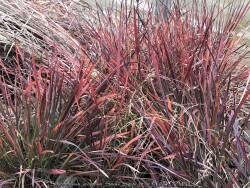

Little bluestem (Schizachyrium scoparium) is a prominent prairie grass usually found in the short to medium grass prairies of Kansas and most common in the midwest and Great Plains. It also occurs sporadically throughout most of the United States in open areas where trees cannot grow. The spring and summer foliage is mint green to blue green. Depending on the variety, they gradually turn a reddish purple color in late summer progressing to deeper reddish purple, red, or orange by fall. At this time when the seed heads have extended, it is at its prettiest. As cold weather sets in and freezes occur, dried foliage turns a pinkish orange with tan and red shades again depending on the variety. Winter color is persistent and lasts until spring cut back in March. Little bluestem is very tolerant of different soils but prefers dry, sandy, loam, or clay soils with plenty of full sun. If planted in rich soil or given too much water, plants tend to grow too tall and flop by late summer. However, there are now improved cultivars that resist flopping. Good air circulation and some wind is needed to avoid rust diseases in humid areas. Sometimes if planted too shallow or if mulched too thickly, plants can heave and die in the winter. In the landscape, little bluestem looks best when planted in medium to large groups giving the look of a miniature prairie. It also combines very well with many other plants that have different textures and colors. Generally if given the proper placement and growing conditions, little bluestem will last indefinitely. Little bluestem as one of the four major grasses (along with Big bluestem, Indiangrass, and Switchgrass) covering millions of acres and Kansas including the Flint Hills. Where and when conditions are safe, it can be burned in late winter or early spring in a prairie or meadow before new growth appears. Many cultivars have been released improving foliage color and flop resistance. Smoke Signal Little Bluestem Grass (Schizachyrium scoparium 'Smoke Signal') has a beautifully refined habit and puts forth a strong show of color in late summer and fall. The glaucous blue-green foliage begins to take on scarlet red tones in late summer, turning a deeper red-purple through the fall. Tiny, tan seed heads appear in early fall on the top half of the stems. An improvement over older cultivars, this grass maintains its strictly upright habit through fall. Smoke Signal is a Walters Gardens Inc. introduction.
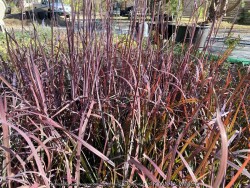

Little bluestem (Schizachyrium scoparium) is a prominent prairie grass usually found in the short to medium grass prairies of Kansas and most common in the midwest and Great Plains. It also occurs sporadically throughout most of the United States in open areas where trees cannot grow. The spring and summer foliage is mint green to blue green. Depending on the variety, they gradually turn a reddish purple color in late summer progressing to deeper reddish purple, red, or orange by fall. At this time when the seed heads have extended, it is at its prettiest. As cold weather sets in and freezes occur, dried foliage turns a pinkish orange with tan and red shades again depending on the variety. Winter color is persistent and lasts until spring cut back in March. Little bluestem is very tolerant of different soils but prefers dry, sandy, loam, or clay soils with plenty of full sun. If planted in rich soil or given too much water, plants tend to grow too tall and flop by late summer. However, there are now improved cultivars that resist flopping. Good air circulation and some wind is needed to avoid rust diseases in humid areas. Sometimes if planted too shallow or if mulched too thickly, plants can heave and die in the winter. In the landscape, little bluestem looks best when planted in medium to large groups giving the look of a miniature prairie. It also combines very well with many other plants that have different textures and colors. Generally if given the proper placement and growing conditions, little bluestem will last indefinitely. Little bluestem as one of the four major grasses (along with Big bluestem, Indiangrass, and Switchgrass) covering millions of acres and Kansas including the Flint Hills. Where and when conditions are safe, it can be burned in late winter or early spring in a prairie or meadow before new growth appears. Many cultivars have been released improving foliage color and flop resistance. Standing Ovation Little Bluestem Grass (Schizachyrium scoparium 'Standing Ovation') is characterized by its wide leaf blades and its blue foliage with red tips throughout the growing season that change to red and maroon in fall with rich purple coloring at the base. It is upright and has a rigid habit that is retained without lodging when plants are grown in rich soils or during container production. Standing Ovation is a North Creek Nurseries Inc. introduction from Pennsylvania.


***Description for this perennial available with future update!***
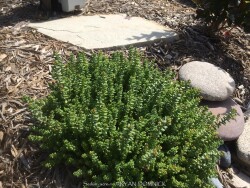

Mossy Stonecrop / Sedum, is also known as Sedum acre
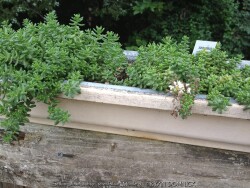



Blue Corsican Sedum, is also known as Sedum dasyphyllum 'Major'
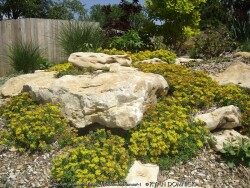

Kamtschaticum Sedum (Sedum kamtschaticum) is known for its compact mats of bright green foliage and yellow-gold flowers in the spring. Fall color turns a beautiful firey orange-red before going dormant. Kamtschaticum Sedum is native to northern China and along the Pacific coast of Siberia including the Kamchatka Peninsula with a similar climate of cold winters and hot summers. Bright green growth emerges early in the spring and spread slowly, rooting a little bit as it spreads but not aggressively. Growth is dense enough to resist most weeds. Kamtschaticum Sedum is useful as a small scale groundcover, rock garden plant, retaining wall plant, or even dry shade gardens. This tough sedum will grow in full sun to full shade in just about any soil except for wet poorly drained ones. Of all of the sedums, this is probably the most resistant to any kind of problems including root rot. I have witnessed clumps surviving and thriving for 20-30 years or more. There is really almost no maintenance with this sedum but you may choose to weed eat it in the winter for a more tidy appearance. The only slight problem is that when grown with too much water, The crown opens up as it flops over and looks slightly untidy. The flowering period is also pretty short. Considered one of the best plants for solving your most difficult dry-shade landscape challenges. Tooth-Leaf Kamtschaticum Sedum (Sedum kamtschaticum var. middendorffianum) is a shorter more drought tolerant variety with tooth-like jagged edges. The clump does not open up and flop. This variety is also more tolerant of full hot sun and shallow soils also making it an ideal roof-garden plant.
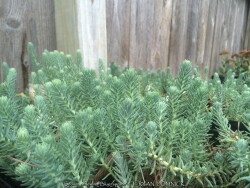

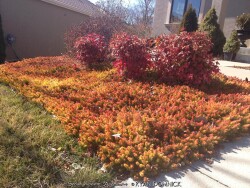

Angelina Gold & Orange Sedum, is also known as Sedum rupestre 'Angelina'
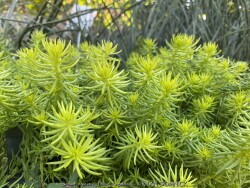

***Description for this perennial available with future update!*** NEEDS EDIT>>>>>> Sedum Prima Angelina has a denser, more compact habit and more vivid golden color than Angelina. According to Plant Delights nursery, "Sedum rupestre 'Prima Angelina' is a superb new improvement of the wildly popular, Sedum 'Angelina'. This compact, better-branched, brighter colored sport was discovered by Ohio's Jared Hughes. Sedum 'Prima Angelina' has thrived in our hot, humid summers. We particularly like that this new gem remains bright gold in cold weather, where its' parent takes on an orange cast in winter. So far, no flowers have been observed on the sport."
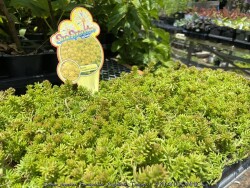

Sunsparkler Angelina's Teacup Gold & Orange Sedum, is also known as Sedum rupestre 'Sunsparkler Angelina's Teacup'
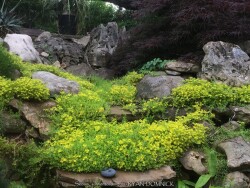

>>>>>This plant can also be in a water garden stream as long as the water is constantly moving: stagnant water is not tolerated. Considered one of the best plants for solving your most difficult dry-shade landscape challenges.


Sedum (Mixed Groundcover flats), is also known as Sedum sp.


Sedum (Mixed Varieties) (large), is also known as Sedum sp.
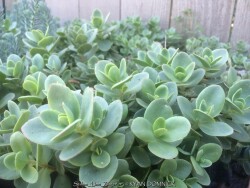

Sedum (Mixed Varieties) (small), is also known as Sedum sp.
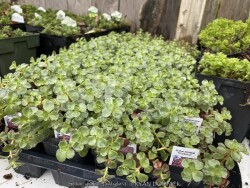

Improved Dragon's Blood Sedum, is also known as Sedum spurium 'Fuldaglut' / 'Fulda Glow'
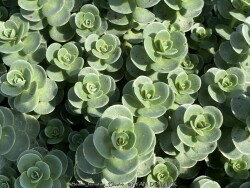

Native White Sedum, is also known as Sedum ternatum
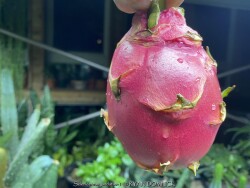

Dragon Fruit cacti are grown for delicious nutritious fruits. This tropical jungle cactus has a few requirements in order to thrive but nothing too hard. Give them bright indirect light and water only when dry. They are usually grown as a house plant in Kansas but can be moved outside if kept in part shade to shade. Leaves can sunburn but morning or filtered sun is ok! Dragon Fruit, like all true cacti, originates in the Americas. It is a sprawling or vining, terrestrial or epiphytic cactus. They climb trees and walls by use of aerial roots and can reach a height of 30 feet in the wild. Protect from temperatures below 45 degrees F and move into a bright window over the winter with no watering. As a winter house plant, it will look presentable all winter long with just a few waterings. Repotting may or may not be needed depending on how large you want the plant to grow; plants can continue to grow in the same pot for years. If repotting, make sure to use a sharp draining highly organic cactus mix with plenty of sand and perlite. This is relatively uncommon plant never seen at the big box stores and will command a higher price than most other houseplants. Plants are usually grown in hanging baskets and take up alot of space. Fruit may or may not occur in this climate; I have seen flowering but not fruit.
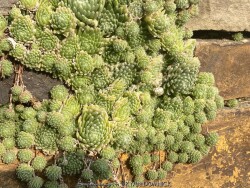

These tiny perennial succulents (Sempervivum sp.) produce various colored mats of foliage rosettes. In favorable conditions they can spread rapidly by offsets; several species are valued in cultivation as groundcover for dry, sunny locations. Hen & Chicks are native to alpine mountainous areas in native to southern Europe and northern Africa. Grow this small native gem in a rock garden, in cracks between rocks, or on top of or in a retaining wall. You may also grow in flat areas like in between stepping stones provided you used a gravelly or sandy base for the stones. It will not tolerate rich moist soils as other plants or weeds will shade it out. Crown rot can occur during lengthy hot humid summer rainy periods. Hen & Chicks do not thrive indoors; aphids and spider mites seem to find them after a few months but overwintering indoors in a cool environment may work. Plants with plenty of time to acclimate will thrive in full sun but be careful not to rush it or sunburning will occur. Generally if moving outside for the summer, allow 2-3 weeks of part shade or morning sun before placing in full sun. If grown in pots and kept on the dry side, you may leave out all winter allowing to freeze solid; plants will go dormant and resume growth in the spring. This is more successful than overwintering inside. Great low maintenance cold hardy succulent. Cobweb Hen & Chicks (Sempervivum arachnoideum) grow tiny and have tiny white hairs resembling cobwebs!
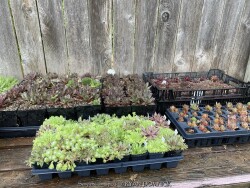

These tiny perennial succulents (Sempervivum sp.) produce various colored mats of foliage rosettes. In favorable conditions they can spread rapidly by offsets; several species are valued in cultivation as groundcover for dry, sunny locations. Hen & Chicks are native to alpine mountainous areas in native to southern Europe and northern Africa. Grow this small native gem in a rock garden, in cracks between rocks, or on top of or in a retaining wall. You may also grow in flat areas like in between stepping stones provided you used a gravelly or sandy base for the stones. It will not tolerate rich moist soils as other plants or weeds will shade it out. Crown rot can occur during lengthy hot humid summer rainy periods. Hen & Chicks do not thrive indoors; aphids and spider mites seem to find them after a few months but overwintering indoors in a cool environment may work. Plants with plenty of time to acclimate will thrive in full sun but be careful not to rush it or sunburning will occur. Generally if moving outside for the summer, allow 2-3 weeks of part shade or morning sun before placing in full sun. If grown in pots and kept on the dry side, you may leave out all winter allowing to freeze solid; plants will go dormant and resume growth in the spring. This is more successful than overwintering inside. Great low maintenance cold hardy succulent.


These tiny perennial succulents (Sempervivum sp.) produce various colored mats of foliage rosettes. In favorable conditions they can spread rapidly by offsets; several species are valued in cultivation as groundcover for dry, sunny locations. Hen & Chicks are native to alpine mountainous areas in native to southern Europe and northern Africa. Grow this small native gem in a rock garden, in cracks between rocks, or on top of or in a retaining wall. You may also grow in flat areas like in between stepping stones provided you used a gravelly or sandy base for the stones. It will not tolerate rich moist soils as other plants or weeds will shade it out. Crown rot can occur during lengthy hot humid summer rainy periods. Hen & Chicks do not thrive indoors; aphids and spider mites seem to find them after a few months but overwintering indoors in a cool environment may work. Plants with plenty of time to acclimate will thrive in full sun but be careful not to rush it or sunburning will occur. Generally if moving outside for the summer, allow 2-3 weeks of part shade or morning sun before placing in full sun. If grown in pots and kept on the dry side, you may leave out all winter allowing to freeze solid; plants will go dormant and resume growth in the spring. This is more successful than overwintering inside. Great low maintenance cold hardy succulent.
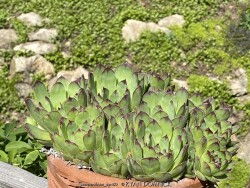

These tiny perennial succulents (Sempervivum sp.) produce various colored mats of foliage rosettes. In favorable conditions they can spread rapidly by offsets; several species are valued in cultivation as groundcover for dry, sunny locations. Hen & Chicks are native to alpine mountainous areas in native to southern Europe and northern Africa. Grow this small native gem in a rock garden, in cracks between rocks, or on top of or in a retaining wall. You may also grow in flat areas like in between stepping stones provided you used a gravelly or sandy base for the stones. It will not tolerate rich moist soils as other plants or weeds will shade it out. Crown rot can occur during lengthy hot humid summer rainy periods. Hen & Chicks do not thrive indoors; aphids and spider mites seem to find them after a few months but overwintering indoors in a cool environment may work. Plants with plenty of time to acclimate will thrive in full sun but be careful not to rush it or sunburning will occur. Generally if moving outside for the summer, allow 2-3 weeks of part shade or morning sun before placing in full sun. If grown in pots and kept on the dry side, you may leave out all winter allowing to freeze solid; plants will go dormant and resume growth in the spring. This is more successful than overwintering inside. Great low maintenance cold hardy succulent. Red-tip Green Hen & Chicks are among the largest, most reliable, and fastest growing.
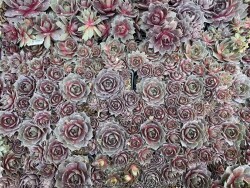

These tiny perennial succulents (Sempervivum sp.) produce various colored mats of foliage rosettes. In favorable conditions they can spread rapidly by offsets; several species are valued in cultivation as groundcover for dry, sunny locations. Hen & Chicks are native to alpine mountainous areas in native to southern Europe and northern Africa. Grow this small native gem in a rock garden, in cracks between rocks, or on top of or in a retaining wall. You may also grow in flat areas like in between stepping stones provided you used a gravelly or sandy base for the stones. It will not tolerate rich moist soils as other plants or weeds will shade it out. Crown rot can occur during lengthy hot humid summer rainy periods. Hen & Chicks do not thrive indoors; aphids and spider mites seem to find them after a few months but overwintering indoors in a cool environment may work. Plants with plenty of time to acclimate will thrive in full sun but be careful not to rush it or sunburning will occur. Generally if moving outside for the summer, allow 2-3 weeks of part shade or morning sun before placing in full sun. If grown in pots and kept on the dry side, you may leave out all winter allowing to freeze solid; plants will go dormant and resume growth in the spring. This is more successful than overwintering inside. Great low maintenance cold hardy succulent. Burgundy Hen & Chicks (Sempervivum tectorum) are brightly colored with new growth emerging bright purple darkening with age.


String of Bananas (Senecio / Curio radicans) grows long green stems with interesting banana-shaped alternating leaves. They are usually grown as a patio or house plant in Kansas. String of Bananas also grow well in hanging baskets as a durable, succulent plant able to survive drying out, heat and dry air like few others! To play is safe, potted plants are best moved in before night temperatures get below 45 degrees F. It is important to avoid the combination of wet and cold. Before extreme cold occurs, move to a bright interior window over the winter with no watering and keep above freezing. As a winter house plant, it will look presentable all winter long with just no waterings. As a permanent house plant, provide bright light and allow the soil to dry between waterings for many years of carefree enjoyment. Generally if moving outside for the summer, allow 1-2 weeks of part shade or morning sun before placing in full sun. Plants with time to acclimate will thrive in full sun but be careful not to rush it or sunburning will occur. Full hot sun over 100 degrees F can also burn the top of the hanging basket killing the stems where they touch the pot rim and dirt. Avoid this by moving into part-shade during the hottest part of the summer. Potted plants are very low maintenance. I have never seen any insect problems on this plant. String of Bananas is the toughest, most trouble-free of the Senecio cascaders.
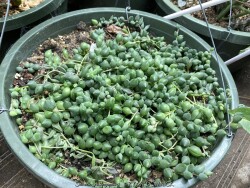

String of Pearls (Senecio / Curio rowleyanus) grows long green stems with interesting sphere-shaped alternating leaves. They are usually grown as a patio or house plant in Kansas. String of Pearls also grow well in hanging baskets as a durable, succulent plant able to survive drying out, heat and dry air like few others! To play is safe, potted plants are best moved in before night temperatures get below 45 degrees F. It is important to avoid the combination of wet and cold. Before extreme cold occurs, move to a bright interior window over the winter with no watering and keep above freezing. As a winter house plant, it will look presentable all winter long with just no waterings. As a permanent house plant, provide bright light and allow the soil to dry between waterings for many years of carefree enjoyment. Generally if moving outside for the summer, allow 1-2 weeks of part shade or morning sun before placing in full sun. Plants with time to acclimate will thrive in full sun but be careful not to rush it or sunburning will occur. Full hot sun over 100 degrees F can also burn the top of the hanging basket killing the stems where they touch the pot rim and dirt. Avoid this by moving into part-shade during the hottest part of the summer. Potted plants are very low maintenance. I have never seen any insect problems on this plant.
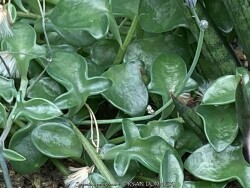

String of Dolphins (Senecio / Curio x peregrinum) grows long green stems with interesting dolphin-shaped alternating leaves. They are usually grown as a patio or house plant in Kansas. String of Dolphins also grow well in hanging baskets as a durable, succulent plant able to survive drying out, heat and dry air like few others! To play is safe, potted plants are best moved in before night temperatures get below 45 degrees F. It is important to avoid the combination of wet and cold. Before extreme cold occurs, move to a bright interior window over the winter with no watering and keep above freezing. As a winter house plant, it will look presentable all winter long with just no waterings. As a permanent house plant, provide bright light and allow the soil to dry between waterings for many years of carefree enjoyment. Generally if moving outside for the summer, allow 1-2 weeks of part shade or morning sun before placing in full sun. Plants with time to acclimate will thrive in full sun but be careful not to rush it or sunburning will occur. Full hot sun over 100 degrees F can also burn the top of the hanging basket killing the stems where they touch the pot rim and dirt. Avoid this by moving into part-shade during the hottest part of the summer. Potted plants are very low maintenance. I have never seen any insect problems on this plant.
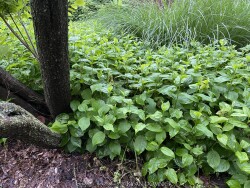

Zig Zag Goldenrod (Solidago flexicaulis) is native to the eastern and central parts of the United States and Canada. This woodland goldenrod, with erect, somewhat zig-zag stems, bears small flower heads at each node along the stem and upper leaves. The oval leaves are a rich green, pointed, and coarsely toothed. Considered one of the best plants for solving your most difficult dry-shade landscape challenges and still providing flowers. Goldenrods are not wind-pollinated and therefore do not cause standard hay fever or allergies. This goldenrod attracts butterflies. Rabbit and deer resistance is good. Zig Zag Goldenrod has been planted in our trial gardens over 10 years ago on a hill in part-sun to dry shade. The slowly expanding clump is virtually maintenance free, only needing trimmed in fate fall. Zig Zag Goldenrod is not well known or available in garden centers but worthy of wider scale landscape use.
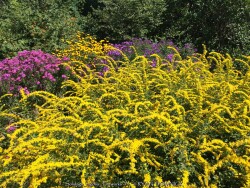

Fireworks Goldenrod (Solidago rugosa 'Fireworks') is the most garden-worthy of the goldenrods! It features dark green upright foliage. As the flower panicle matures, the expanding buds create a fine-textures cloud-like effect for about a month before the flowers open. When the flowers finally open in September, the radiating form really looks like fireworks! After flowering, the dried flower structure holds up well into fall offering winter interest until the first wet heavy snow. The species, Solidago rugosa, is native to the eastern and central parts of the United States and Canada. It is a highly adaptable goldenrod occuring in open moist areas such as low woods, meadows, old fields, pine barrens, and bogs. It is more tolerant of wet soils that other goldenrod. It prefers locations in full sun in average to moist soils that are well-drained but is adaptable to part shade or dappled shade. In Eastern Kansas, typically our 40 inches of rainfall is sufficient without extra water if planted in good soils. During the drought years in Eastern Kansas of 2011 and 2012, many Fireworks Goldenrods planted in landscapes that were not watered survived but dried up as flowers were trying to form. Goldenrods are not wind-pollinated and therefore do not cause standard hay fever or allergies. This goldenrod attracts wide variety of insects, including small bees, wasps, flies, small butterflies. Rabbit and deer resistance is good. The slowly expanding clump is virtually maintenance free, only needing trimmed in fate fall. Fireworks Goldenrod is generally very pest and disease resistant and can spread by creeping rhizomes or seed. Fireworks Goldenrod has been planted in our trial gardens over 18 years in mostly full sun with average garden soil. This is among our favorite perennials with truely 4 seasons of interest!